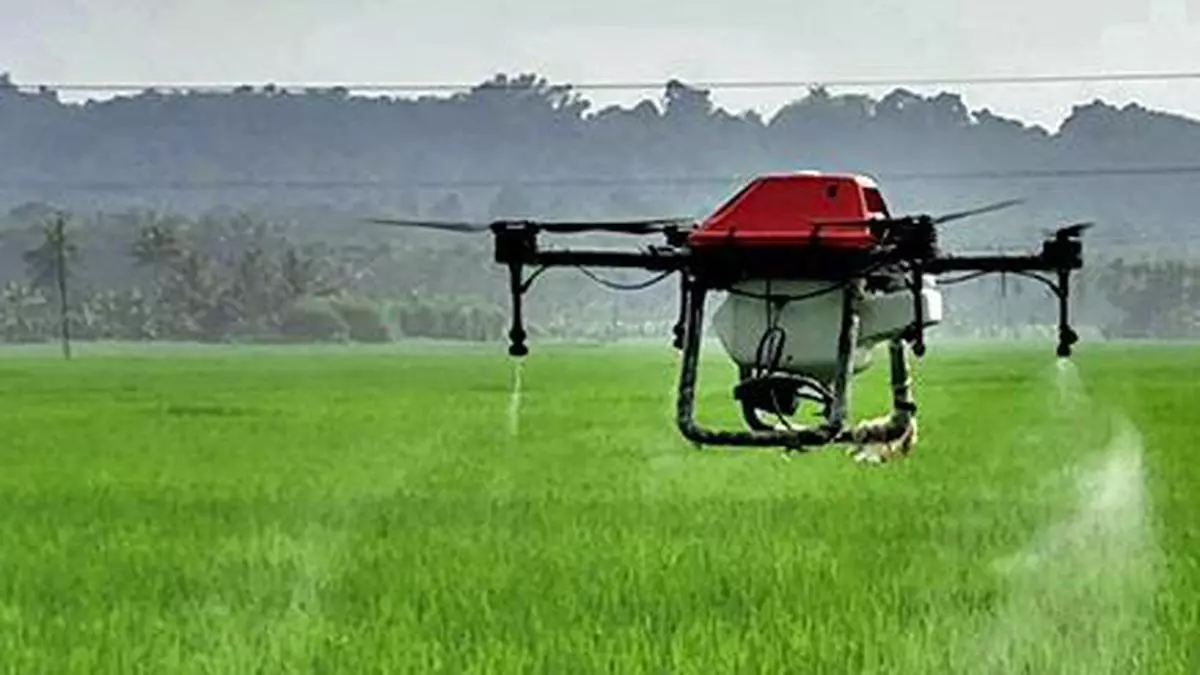A game-changer, drone revolution poised to transform Indian agriculture
Agriculture serves as the backbone of the Indian economy, underpinning approximately 18 per cent of the nation’s annual GDP and serving as a primary source of livelihood for an estimated 60-70 per cent of its populace. However, this critical sector finds itself ensnared in a complex web of challenges that demand innovative solutions to navigate.
India already holds the distinction of being the world’s most populous nation and its population is only growing further, driving an ever-increasing demand for food. This relentless surge in food demand places unprecedented pressure on India’s farmlands, which are now tasked with the monumental challenge of producing more food than ever before.
Yet, the path to boosting agricultural productivity is fraught with obstacles exacerbated by the looming spectre of climate change and its myriad ramifications. Global warming and shifting climate patterns have thrown traditional agricultural practices into disarray, making the quest for increased farmland productivity an uphill battle.
While mechanisation has long been heralded as a potential panacea for India’s agricultural woes, the stark reality of small landholdings and the precarious plight of many farmers renders large-scale mechanization a lofty, if not wholly impractical, aspiration. Considering these constraints, the search for viable solutions to the productivity conundrum becomes increasingly urgent.
Paradigm shift
Enter the drone revolution — a transformative paradigm shift poised to revolutionise Indian agriculture as we know it. Drones emerge as the long-awaited game-changer, wielding unparalleled potential to bolster agricultural yields while circumventing the logistical constraints inherent in traditional mechanisation.
By leveraging drone technology, farmers can harness the power of precision agriculture without incurring prohibitively high capital expenditures or grappling with the logistical complexities of operating machinery on small, fragmented plots of land. Moreover, drones hold the key to unlocking the untapped potential of digital agriculture, ushering in an era of unprecedented promise and prosperity for Indian farmers. The adoption of drones in agricultural practices promises a multitude of productivity-enhancing benefits that extend far beyond conventional methods.
At its core, drones offer a cost-effective and efficient means of augmenting agricultural productivity. By enabling targeted spraying of insecticides and pesticides, drones mitigate environmental impact and minimize health risks associated with traditional spraying methods.
Furthermore, drones facilitate swift intervention in the event of pest outbreaks, allowing farmers to contain and address such threats before they can inflict irreparable damage to crops. Beyond their immediate applications, drones serve as the linchpin of agricultural digitisation, unlocking a treasure trove of data-driven insights that empower farmers to make informed decisions. Equipped with cutting-edge sensors, drones provide real-time monitoring of soil conditions, moisture levels, crop health, and a myriad of other critical parameters. This wealth of data not only enables farmers to optimise resource allocation, but also equips them with invaluable insights into crop water requirements, soil nutrient deficiencies, and pest infestations.
Heralding the dawn of a new era
Moreover, drones play a pivotal role in weather monitoring, offering farmers timely and accurate forecasts that are indispensable in an era of increasingly erratic weather patterns. By leveraging weather data, drones empower farmers to preemptively safeguard their crops against adverse weather events and pest outbreaks, thereby minimising losses and maximising yields.
In essence, drones herald the dawn of a new era of precision agriculture, wherein resources are allocated with surgical precision, and soil health is safeguarded for generations to come. Recognising the transformative potential of drones, the Indian government has taken proactive measures to facilitate their widespread adoption across the agricultural landscape with an objective to increase efficiency and profitability, while minimizing environmental impact. Initiatives such as the National Drone Policy and Drone Rules 2021, coupled with financial incentives such as the Kisan Drone Scheme, underscore the government’s commitment to fostering a conducive ecosystem for drone adoption.
To facilitate the development of more precise, safer, and profitable phytosanitary applications in certain specific scenarios and geographies, local regulatory frameworks must adapt to cover new categories, such as drone applications and other precision agriculture technologies. Risk assessments and consequent decisions to authorize the use of phytosanitary products must be based on new, clearly defined specific criteria, considering realistic, pragmatic, and practical parameters, allowing to scientifically demonstrate that drone applications imply equivalent or lower risks of negative impact on human health and the environment than any existing alternative application methods.
By incentivizing innovation and embracing disruptive technologies, India is poised to chart a course towards sustainable agricultural development, unlocking unprecedented levels of productivity and ushering in a new era of abundance for its farmers. The advent of the drone revolution could in the future come to be seen as a watershed moment in the history of Indian agriculture, as transformative as the Green Revolution that paved the way for the country to attain food security.
As drones take flight across India’s farmlands, they carry with them the promise of a brighter, more bountiful future, where the age-old pursuit of sustenance is imbued with the transformative power of technology.
(The author is Head of Retail & Business Development, UPL SAS)
